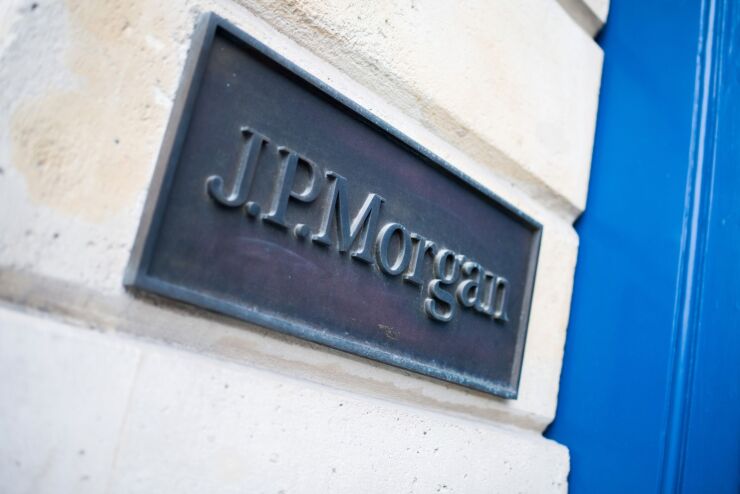If the name of JPMorgan’s blockchain and digital assets team, Onyx, sounds mysterious, that’s by design.
“If someone says Onyx, you kind of know what it is, but you don't really know what it is,” said Umar Farooq, CEO of Onyx by JPMorgan. “That's how we landed on Onyx. It's a color and a material, which some people would say is black, but most people would say it's kind of black.”
The group of 200 people, mostly developers, created a

The team is building distributed ledger technology that reimagines many of the things the bank does for its clients, including deposits, cross-border payments, check processing and securities trading. The group has built a payment information network called Liink that 75 banks are currently using. It has evolved JPM Coin, the bank’s take on digital currency, to be a digital representation of a depository account. Onyx technology is also used to tokenize and trade assets.
To look at how the largest U.S. bank, with $2.6 trillion of assets, is approaching blockchain technology and digital assets is to get a sense of where other banks are likely to put their efforts in coming years.
“Onyx from JPMorgan is as of today a clear leader in using distributed ledger technology to move money and information around the world without the limitations of traditional payment rails,” said Sankar Krishnan, executive vice president, capital markets and banking at Capgemini Americas.
Krishnan expects the other four of the top five U.S. banks to create similar networks so they can compete with JPMorgan in B2B payments, securitization, collateralization and decentralized finance.
“Citi is moving fast to respond to the market opportunity and a couple of European banks are watching the space very closely,” he noted.
Vikas Shah, managing director of Rosenblatt Securities, also sees JPMorgan as the leader in this area.
“Their initiative is the oldest of all the banks and most mature,” he said. “Other large banks like Citi and Bank of America are also looking into such initiatives, but they are not as advanced as JPMorgan’s.”
It could lead to significant cost savings for the bank, assuming the technology can meet all regulatory and compliance mandates as well as handle throughputs as fast as hundreds of thousands of transactions per second, Shah said.
He also pointed to notable work being done by Figure, the financial technology company founded by
Everything on a blockchain
The Onyx group is guided by an overarching belief that the movement of money, assets and information is going to converge.
“We believe that having a platform where you can move value and assets seamlessly across the world is fundamentally a new way of thinking about things and it can have a very meaningful impact on how future infrastructure works,” Farooq said.
Today, money and securities move around in closed-loop ecosystems that are controlled by central parties, Farooq pointed out: Money moves on Fedwire, ACH and Clearinghouse RTP rails. Securities move through clearing networks and dark pools.
“By combining those two, you create new value propositions that never existed,” Farooq said. “The creation of an internet where you can move all these things by unifying the technology and representing them as a token is very interesting to us.”
This could allow a broker-dealer to borrow against securities for five minutes, he said, whereas in the current infrastructure it could take hours just to confirm the wire. This could help solve a short-term cash-flow problem.
Because of its belief in the concept of an eventual internet of money and its accumulated blockchain experience of the last seven years, the bank is no longer interested in doing limited proofs of concept with third parties.
“Senior management believes if we want to have a real impact — and this has a chance of fundamentally rearchitecting our financial services work, even if it's 20 years out — then we need to have deep expertise in the space,” Farooq said. “And that's why our team has gone from a couple of people seven years ago to now a couple hundred people” who came from all parts of the bank.
“We want to make sure that if the world goes in this direction, that we are fundamentally playing at the core level versus playing around the edges,” he said.
JPMorgan is uniquely positioned for this work because of the amount of money it moves: about $10 trillion a day, Farooq said.
The Onyx Digital Assets platform
JPMorgan has been working on blockchain and digital asset technology for seven years. In March 2016, it demonstrated
Later that year, it unveiled Quorum, a protocol layer for Ethereum developed under the leadership of
The Onyx Digital Assets platform, which launched in December 2020, builds on that earlier work.
“Think of our Onyx Digital Assets platform as a layer on top of ConsenSysQuorum,” Farooq said. The added layer supports tokenization, swaps and issuance. Built on top of that are specific applications like intraday repo and money market funds tokenization. So far, it has executed intraday repo transactions of more than $320 billion in notional value.
The ability to tokenize money market funds “is probably more groundbreaking if it achieves scale,” Farooq said. This would let big trading companies post margin more easily on derivative trades.
One use case for Onyx Digital Assets that Farooq is excited about is smart money.
The bank worked with the German manufacturer Siemens to test an automated treasury solution with programmable payments. This means the payments can be triggered by events, removing the need for human intervention to discover, calculate and confirm the required conditions needed before a payment can be executed.
“Say you are an energy company and you want to move money based on events that happen: an oil price, shipping costs, temperature — for example, if you want to get more oil into Texas because it's going to get really hot and power generation demand will increase — right now, there is no good way to automate all of that process,” Farooq said. “What happens is you have an army of people sitting in the energy company trying to optimize money movement.” Such rules could be written into a smart contract on the distributed ledger and get triggered and executed automatically.
The result could be faster transactions and the answer to a common liquidity problem for businesses — the need to assign excess liquidity buffers during periods of treasury team downtime, such as weekends, bank holidays and overnight.
JPMorgan Chase is said to be dropping its Quorum blockchain technology, and little is happening with other blockchain projects that have been in the works for years. What gives?
Another use case that interests Farooq is Project Guardian, a digital assets pilot using tokenization on public blockchains that the Monetary Authority of Singapore announced in May. Tokenized bonds and deposits will be used in a permissioned liquidity pool for transactions in which institutional investors will borrow and lend on a public blockchain. Regulated financial institutions will act as “trust anchors,” starting with JP Morgan and DBS Bank.
“The reason that something like Project Guardian could be very transformative is that existing financial products, like treasuries and deposits, will begin to step out of permissioned networks and utilize learnings from the public blockchain space,” Farooq said. “We could begin to see JPM Coin or tokenized Treasuries on a public ecosystem like Ethereum or Polygon.”
JPM Coin is a deposit account, not a stablecoin, Farooq said. It is compliant with existing regulations of deposit products. Clients have used it to move money in $10.5 billion worth of transactions to date.
“Stablecoins are still a bit of an unknown quantity in terms of what they actually mean, especially in the U.S.,” Farooq said. “There's no real equivalent out there. And I think they could be quite capital inefficient given the need for reserving 100% or even more with high quality liquid assets.”
In a year-old Onyx project called Liink, the team has created a cross-border information exchange that has executed more than 45 million messages to date. One application in the works for Liink, called Confirm, would provide validation for cross-border payment recipients. This would not replace Swift’s messaging, but complement it.
The team is also working to put check processing on the Onyx blockchain.
“Hundreds of millions of checks are sent from banks to lock boxes serving corporate clients,” said Sushil Raja, global head of Liink by J.P. Morgan. “A key element of this ecosystem is it’s concentrated, so integrating with a small handful of key players means dramatically increasing efficiency across the system.”
Bringing check processing onto the Liink network will let banks send check images to one another and help save the costs and ESG toll of sending physical checks through the mail, Raja said.
He expects the service to go live later this year.







